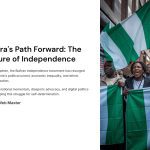 Once a forgotten conflict in the annals of African history, the Biafran independence movement has recently surged back into global consciousness. As political unrest, economic inequality, and ethnic marginalization continue to strain Nigeria’s unity, the question of Biafra’s independence becomes increasingly relevant. With new generational momentum, diasporic advocacy, and a rapidly digitizing political space, what does the future truly hold for Biafra? In this post, we explore the evolving nature of the movement, the forces driving its resurgence, and potential outcomes that may redefine not only Nigeria but also how modern separatist struggles unfold.
Once a forgotten conflict in the annals of African history, the Biafran independence movement has recently surged back into global consciousness. As political unrest, economic inequality, and ethnic marginalization continue to strain Nigeria’s unity, the question of Biafra’s independence becomes increasingly relevant. With new generational momentum, diasporic advocacy, and a rapidly digitizing political space, what does the future truly hold for Biafra? In this post, we explore the evolving nature of the movement, the forces driving its resurgence, and potential outcomes that may redefine not only Nigeria but also how modern separatist struggles unfold.

The Historical Echo: Why Biafra Still Resonates Today
The Biafran war of 1967–1970 left deep scars, but its legacy continues to influence the present. The Eastern Region’s attempted secession resulted in a brutal civil war, leading to over a million deaths, mostly from starvation. Despite the official end of conflict, the Igbo people and other Eastern minorities still experience systemic exclusion and underrepresentation. This persistent marginalization sustains the desire for autonomy. Activists argue that the federal structure of Nigeria remains lopsided, with disproportionate political and economic power favoring the North and West. Consequently, Biafra has become a symbol of resistance against injustice, as much as a call for sovereignty.

New-Age Nationalism: Digital Tools and Global Advocacy
Today’s Biafran movement is not waged on the battlefield but across social media platforms, digital petitions, and international forums. Movements such as the Indigenous People of Biafra (IPOB) have harnessed the power of the internet to mobilize support, especially among the youth and diaspora. These new-age activists spread real-time updates, launch coordinated protests worldwide, and utilize decentralized tools to raise awareness. The result is a robust, transnational network that transcends borders. Biafra’s digital visibility is steadily rising, allowing the cause to circumvent state-controlled narratives within Nigeria.

Political Pushback and Governmental Response
The Nigerian government classifies IPOB as a terrorist organization, reflecting its zero-tolerance stance toward secessionist rhetoric. Crackdowns on protests, arrests of key figures like Nnamdi Kanu, and internet shutdowns reveal the extent of federal resistance. However, these measures have backfired in some respects, radicalizing a segment of the population and gaining the movement sympathy from international human rights groups. The lack of genuine dialogue and political inclusivity has further alienated Eastern communities. Without a shift toward a more federal or confederal system, discontent is likely to deepen.

Socioeconomic Catalysts: Poverty, Inequality, and Youth Unrest
Biafra’s revival is not just a political cry—it is also deeply rooted in economic frustration. Eastern Nigeria, despite being resource-rich, suffers from chronic underdevelopment, high unemployment rates, and poor infrastructure. The region’s youth, facing bleak prospects, increasingly embrace separatist ideals as a solution. They view Biafra as a means to reclaim dignity, economic justice, and local empowerment. The disconnect between Abuja and the Igbo heartland has widened, feeding perceptions of intentional neglect. Without tangible development and job creation, secessionist sentiment will likely grow stronger, particularly among digital-native generations.

Regional and International Implications of Biafran Independence
The push for Biafra carries significant geopolitical implications. Nigeria, as Africa’s most populous nation and largest economy, is a key regional stabilizer. A successful Biafran secession could embolden other separatist movements across the continent—from Cameroon’s Anglophone regions to Ethiopia’s Tigray. International stakeholders, including ECOWAS, the African Union, and global superpowers, are thus cautious. While overt support for Biafra remains minimal, human rights abuses committed by Nigerian authorities have sparked criticism. As global norms evolve around self-determination and minority rights, Biafra’s case might gain moral leverage.

Scenarios Ahead: Independence, Restructuring, or Repression?
Looking ahead, the Biafran independence movement faces three main trajectories. First, a peaceful negotiation leading to a referendum or significant restructuring of Nigeria’s federal system, though unlikely in the short term. Second, sustained digital activism might lead to global recognition similar to Palestine or Catalonia—symbolic, if not official. Third, continued state suBiafran independenceppression may deepen insurgency and radicalization. Ultimately, the movement’s success will depend on strategic nonviolence, diplomatic alliances, and the Nigerian state’s willingness to reform. Either way, Biafra is no longer a buried past—it is an unfolding future.
*Capturing unauthorized images is prohibited*


